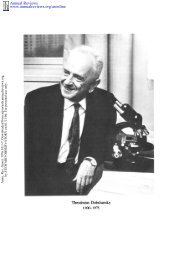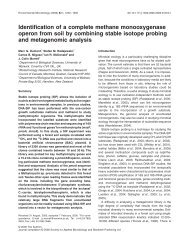Conservation of the vaquita Phocoena sinus - The Department of ...
Conservation of the vaquita Phocoena sinus - The Department of ...
Conservation of the vaquita Phocoena sinus - The Department of ...
Create successful ePaper yourself
Turn your PDF publications into a flip-book with our unique Google optimized e-Paper software.
182 L. Rojas-Bracho, R. R. Reeves and A. Jaramillo-Legorreta<br />
Table 1. Chronology <strong>of</strong> research on <strong>the</strong> <strong>vaquita</strong> and its habitat<br />
1958 Vaquita described as a new species (Norris & McFarland, 1958).<br />
1961 First reports <strong>of</strong> <strong>vaquita</strong> kills in fishing gear: totoaba gill nets and trawlers (Norris & Prescott, 1961).<br />
1968 First data on ecology: stomach contents reveal feeding on small, shallow-water, bottom-dwelling fishes<br />
(Fitch & Brownell, 1968).<br />
1975 IWC Scientific Committee mentions biology <strong>of</strong> <strong>vaquita</strong> and concerns about incidental mortality in<br />
shark and totoaba fishery in <strong>the</strong> published report <strong>of</strong> <strong>the</strong> first meeting on smaller cetaceans, Montreal,<br />
1974 (IWC, 1975).<br />
1976 Villa-Ramírez expresses concern about <strong>vaquita</strong>’s status.<br />
Brownell presents first review <strong>of</strong> <strong>vaquita</strong>’s status and identifies potential risk factors (FAO Advisory<br />
Committee on Marine Resources Research, Working Party on Marine Mammals, Bergen, Norway;<br />
not published until 1982).<br />
1983 ‘Experimental’ 10-year totoaba fishery initiated by Instituto Nacional de la Pesca. Fourteen <strong>vaquita</strong><br />
deaths in 1985–86 reported by Robles et al.<br />
(1987) and 4 by Fleischer (1994).<br />
1985 Instituto Tecnológico y de Estudios Superiores de Monterrey-Guaymas (ITESM) starts <strong>vaquita</strong><br />
research programme that will produce much important new information on <strong>vaquita</strong> biology, ecology<br />
and incidental mortality (Vidal, 1995).<br />
1986 Seven <strong>vaquita</strong>s recovered from 1985 to 1986 experimental totoaba fishery and used for studies <strong>of</strong><br />
external morphology (Robles et al., 1986).<br />
Silber starts first extended field studies resulting in new insights on behaviour, distribution and<br />
abundance.<br />
1987 First description <strong>of</strong> external morphology (Brownell et al.,<br />
1987) and more reliable field identification<br />
during surveys.<br />
1993 First systematic survey using line-transect methods to estimate <strong>vaquita</strong> abundance and distribution<br />
(Gerrodette et al.,<br />
1995; Barlow et al.,<br />
1997).<br />
Taylor & Gerrodette (1993) use <strong>vaquita</strong> and nor<strong>the</strong>rn spotted owl as case studies to illustrate<br />
importance <strong>of</strong> statistical power (Type I and Type II errors) in conservation biology.<br />
1996 First empirical study <strong>of</strong> <strong>vaquita</strong> life history reveals lower rate <strong>of</strong> increase than for o<strong>the</strong>r porpoise<br />
populations (Hohn et al.,<br />
1996).<br />
First estimate <strong>of</strong> abundance indicates <strong>vaquita</strong> population size in low hundreds (Barlow et al.,<br />
1997).<br />
1997 National Marine Mammal Program established by National Fisheries Institute to promote research<br />
and international collaboration, particularly with <strong>vaquita</strong> (Rojas-Bracho & Jaramillo-Legorreta).<br />
International Committee for <strong>the</strong> Recovery <strong>of</strong> Vaquita (CIRVA) is created and holds first meeting with<br />
participation <strong>of</strong> researchers from Europe, United States, Canada and Mexico; concludes in risk<br />
assessment that incidental mortality in fisheries is main threat to <strong>vaquita</strong> survival (Rojas-Bracho &<br />
Taylor, 1999).<br />
Joint Mexico–US cruise to estimate <strong>vaquita</strong> abundance as recommended by CIRVA, covers all known<br />
and suspected habitat <strong>of</strong> <strong>the</strong> species.<br />
Acoustic surveys start with support from International Fund for Animal Welfare (IFAW), World<br />
Wildlife Fund – US and Marine Mammal Commission (MMC).<br />
1999 CIRVA endorses new abundance estimate <strong>of</strong> 567 individuals (95% CI 177–1073; Jaramillo-Legorreta<br />
et al.,<br />
1999) and makes recommendations including to reduce by-catch to zero.<br />
2000 National Fisheries Chart is published and states that <strong>vaquita</strong> by-catch should be zero.<br />
First quantitatively robust estimate <strong>of</strong> by-catch is published (D’Agrosa et al.,<br />
2000). Incidental<br />
mortality from a single port estimated to be 39 <strong>vaquita</strong>s/year.<br />
2004 IFAW and MMC support acquisition <strong>of</strong> <strong>the</strong> first research vessel dedicated to studying <strong>vaquita</strong>s and<br />
o<strong>the</strong>r marine mammals <strong>of</strong> nor<strong>the</strong>rn Gulf <strong>of</strong> California: KOIPAI YÚ – XÁ, meaning those’ who<br />
come back with <strong>the</strong>ir eyes in <strong>the</strong> water’ in Cucapá language.<br />
2005 16th Biennial Conference on <strong>the</strong> Biology <strong>of</strong> Marine Mammals (San Diego, California) holds special<br />
<strong>vaquita</strong> event. Officers from Mexico’s federal government attend and meet with more than 20<br />
scientists to discuss <strong>vaquita</strong> science and conservation.<br />
FAO, Food and Agriculture Organization; IWC, International Whaling Commission.<br />
© 2006 <strong>The</strong> Authors. Issue compilation © 2006 Mammal Society,<br />
Mammal Review,<br />
36, 179–216




